By Kathy Conroy, Apr 16, 2015
This article offers a comparison of international investment in US Hotels during periods of strong hotel operating performance and a close look at Florida.
In September 2013, my colleague at HVS Miami, Andrew Cohan MAI, published an article entitled “Miami’s Leap to Global Gateway Status”. In that article, Cohan pointed out several interesting facts denoting Miami’s shift to a global or world gateway city. One of the factors noted by Cohan was the movement in the HVS Hotel Valuation Index for Miami — from just above the national average index in 2002 to almost four times the national average index by 2011.
It has been my opinion that another one of the key influences for a United States city to achieve “world city status” has been the willingness of foreign capital to invest in the local real estate. It has been my observation that the successful marketing of United States’ cities to foreign travelers as tourist destinations eventually leads to increased foreign investment in both the ‘local’ real estate and hotel assets within the destination city. And as is typical, most investors want to buy hotels when industry performance is strong.
Thus, I thought it would be interesting to compare how the volume of foreign investment in hotel assets in US cities has changed from the prior strong three-year period in operating performance experienced by the US hotel market during 2006 to 2008, to the most recent three-year performance of 2012 to 2014, which has also been characterized by a strong operating performance.
The tables below recap data collected by Real Capital Analytics (RCA) and highlight the top nine (9) US cities relative to the purchase of hotel assets with foreign capital during the period of 2006 to 2008, as well as the primary origin of said foreign capital.
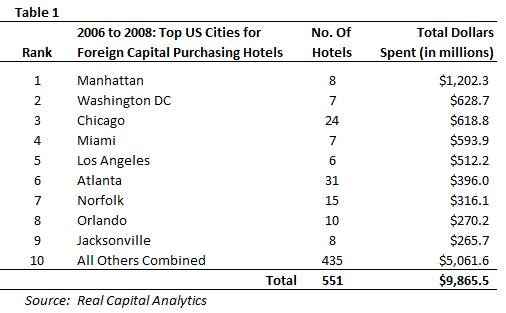
Table 2 below shows the top sources of foreign capital during the 2006 to 2008 period surveyed. Canada was the largest investor in US hotels at 3.0 billion, with the UAE in second place at $2.2 billion, followed by a mix of European and Middle East capital filling the top 5 rankings.
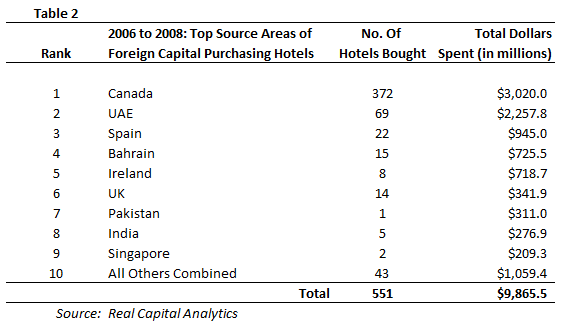
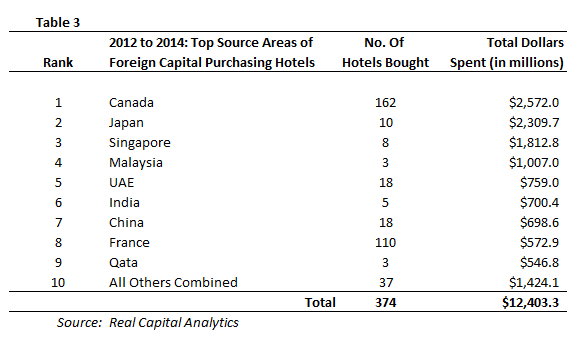
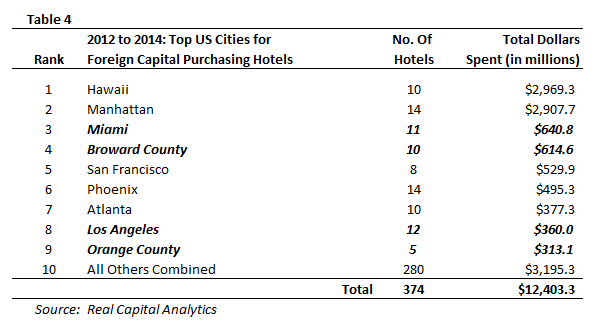
It is also worth pointing out that Washington DC and Chicago did not make the top rankings in the latest survey, nor did Jacksonville and Orlando, all of which were part of the top rankings in the 2006 -2008 survey. As such, it appears that more of the Sunbelt cities are benefiting from the influx of foreign capital into hotel acquisitions versus the case during the 2006 to 2008 timeframe.
A more detailed comparative look at the “world cities” of Manhattan, Los Angeles, and Miami in Tables 5 through 7 below reveals some additional shifts in foreign capital investment in hotels in these cities between the two periods surveyed:
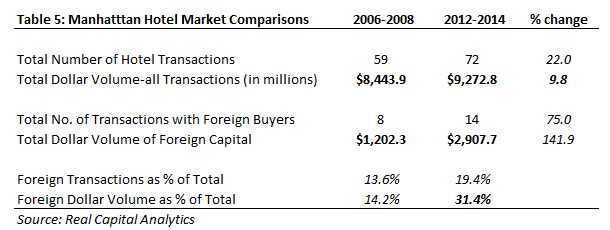
- The total dollar volume of hotel transactions in Manhattan increased 9.8%;
- The total dollar volume of foreign capital purchasing hotels increased by 142%; and
- The percentage of foreign capital dollars involved in purchasing hotels increased significantly from 14% to 31%.
- And the percentage of foreign transactions (of the total number of hotel transactions) increased from 13.6% to nearly 20% as well.
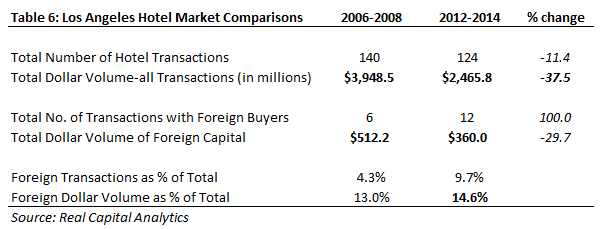
- The total dollar volume of hotel transactions in Los Angeles decreased 37.5%;
- The total dollar volume of foreign capital purchasing hotels decreased by 29.7%; and
- The percentage of foreign capital dollars involved in purchasing hotels increased slightly from 13.0% to 14.6%.
- Once again, when comparing the foreign investment segment of the total number of transactions, the percentage attributed to foreign investors increased from 4% in 2006-2008 to nearly 10% in the 2012-2014 period.
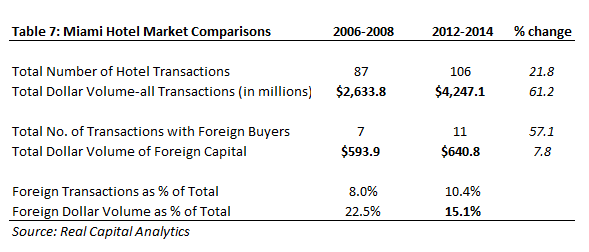
- The total dollar volume of hotel transactions in Miami increased by an astounding 61.2%;
- The total dollar volume of foreign capital purchasing hotels increased by 7.8%; and
- The percentage of foreign capital dollars involved in purchasing hotels decreased from 22.5% to 15.1%.
- And when once again taking a look a the percentage of total transactions in Miami, the those transactions by foreign investors increased from 8% in 2006-2008 to more than 10% in the 2012-2014 period of time.
In summary, with Miami’s shift in status to a global gateway “world city”, the sheer dollar volume of total capital investing in the Miami hotel market has increased dramatically from the 2006-2008 time period to the 2012-2014 time period. I believe this is attributable to both Miami’s significantly increasing hotel values, as well as its investment appeal to both US and foreign investors.
It is interesting to note that the dollar volume of foreign capital investing in the Miami hotel market, which has always been present over the years, has remained relatively steady, increasing from $593.9M during the 2006-2008 time period to $640.8M during the 2012-2014 time period. Highly similar to Los Angeles, foreign capital dollars has recently accounted for about 15% of the total dollar volume of hotel transactions in Miami during the last three calendar years surveyed.
Finally, it is important to note that the Broward County hotel market, which borders the Miami market to the north, has also emerged as a more desirable investment area for foreign capital since the 2006-2008 time period. When Miami-Dade county and Broward county are combined into the ‘South Florida marketplace’ they have now become the third largest area in the US for foreign dollar investment in hotel assets.
How interesting it will be to follow the trends of foreign investments in major US cities? How interesting it will be to see which cities are to be found appealing down the road, or to see where the hills and valleys may lead as operating performance of hotels continue on a strong path. And for those of us in Florida, how interesting it will be to see if the Miami and Broward markets continue to merge and even expand as a desirable foreign investment in the coming years.
_________________
This article was featured in the April 12, 2015 edition of Hotelexecutive.com and is reprinted with permission.

